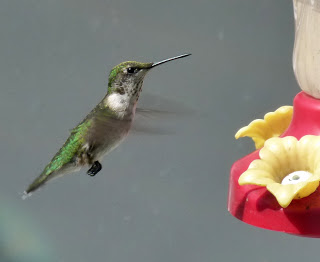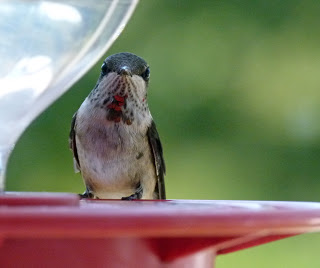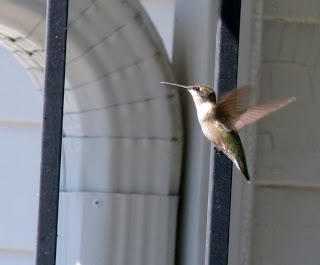When you come to Mahan Manor at the Nature Preserve, look at the garden right by the driveway. Several hummingbird feeders hang there, where they are a popular spot for our family of Ruby-throated Hummingbirds. Since the Ruby-throated is the only Hummingbird which breeds in eastern North America, this identification is pretty easy. The staff enjoys watching from the kitchen window as they zoom around, chasing each other away from the feeders, chirping and humming.
Scientists place hummingbirds and swifts in the same taxonomic order, the Apodiformes. The name means “without feet,” which is certainly how these birds look most of the time. In fact, if I didn’t know better, I’d think they don’t have wings either since they can flap 53 times per second, making the wings pretty well invisible. The extremely short legs of the Ruby-throated Hummingbird prevent it from walking or hopping. The best it can do is shuffle along a perch. Nevertheless, it scratches its head and neck by raising its foot up and over its wing.
The Ruby-throated Hummingbird does not show a strong preference for any particular color of feeder. Instead, it prefers specific feeder locations. But Ruby-throated Hummingbirds prefer to feed on red or orange flowers, which is probably why the manufacturers make feeders red. Like many birds, they have good color vision and can see into the ultraviolet spectrum, which humans can’t see. Please don’t use the commercial nectar mix with red dye. It’s easy to make nectar yourself using 1/4 cup of sugar per cup of plain water.They love it! The nectar needs to be changed often, especially if you have ants, and the feeder should be well scrubbed too.
Ruby-throated Hummingbirds feed on the nectar of red or orange tubular flowers such as trumpet creeper, cardinal flower, honeysuckle, jewelweed, bee-balm, red buckeye and red morning glory, as well as at hummingbird feeders and, sometimes, tree sap. Hummingbirds also catch insects in midair or pull them out of spider webs. Their main insect prey includes mosquitoes, gnats, fruit flies, small bees and also spiders. Ruby-throated Hummingbirds sometimes take insects attracted to sap wells or pick small caterpillars and aphids from leaves.
Although hummers look as if they are drinking through a straw with those long beaks, they really don’t. They lap up nectar with their tongues from flowers and feeders. A Hummingbird’s tongue is grooved like the shape of a “W”, and has tiny hairs on the tip to help lap up nectar. Its beak is generally shaped like any other bird beak, just longer in proportion to its body. The edges of the top beak overlap the edges of the bottom beak, and the bottom beak is slightly flexible.
The gorget is the red coloring on the throat of the males. Depending on the light, it sometimes looks black instead of red. This is an immature male who is just growing his red gorget. It looks like he has five o’clock shadow, doesn’t it? Male Ruby-throated Hummingbirds don’t stick around long. Pairs are together long enough for courtship and mating – just a matter of days to weeks. Then he’s off on his own, and may begin migration by early August. The female raises her family all by herself, making a nest the size of large thimble, directly on top of the branch rather than in a fork. It’s made of thistle or dandelion down held together with strands of spider silk and sometimes pine resin. She incubates the pea-sized eggs for about two weeks, and in another three weeks they are ready to leave the nest.
Like all hummingbirds, Ruby-throats are precision fliers with the ability to fly full out and stop in an instant, hang motionless in midair, and adjust their position up, down, sideways, and backwards with minute control. They dart between nectar sources with fast, straight flights or sit on a small twig keeping a lookout, bill waving back and forth as the bird looks around. Male Ruby-throated Hummingbirds aggressively defend flowers and feeders, leading to spectacular chases and dogfights, and occasional jabs with the beak.
Look how long her wings are when they are still! Sometimes their eyes look like eyes on people painted in Egyptian tombs, with a large white space around the dark center. That effect is the result of white feathers around the small completely dark eye. Hummingbirds migrate to Central American by flying across the Gulf of Mexico in a 20 hour marathon flight. They do NOT hitchhike on the backs of geese, eagles or any other bird!
They will be leaving the Kentucky area before too much longer, so it is important to keep your feeders full of fresh nectar during September. Hummingbirds will not get addicted to a hummingbird feeder filled with nectar, and will leave when they need to. But a Hummingbird can double his/her weight before migration, so it needs a good supply of food before leaving on migration.










